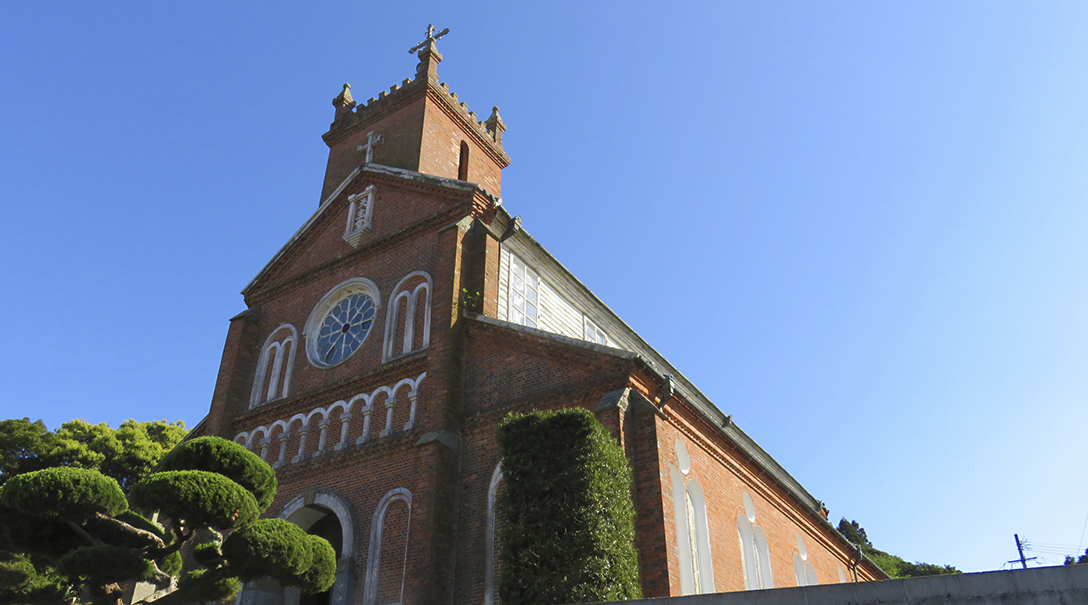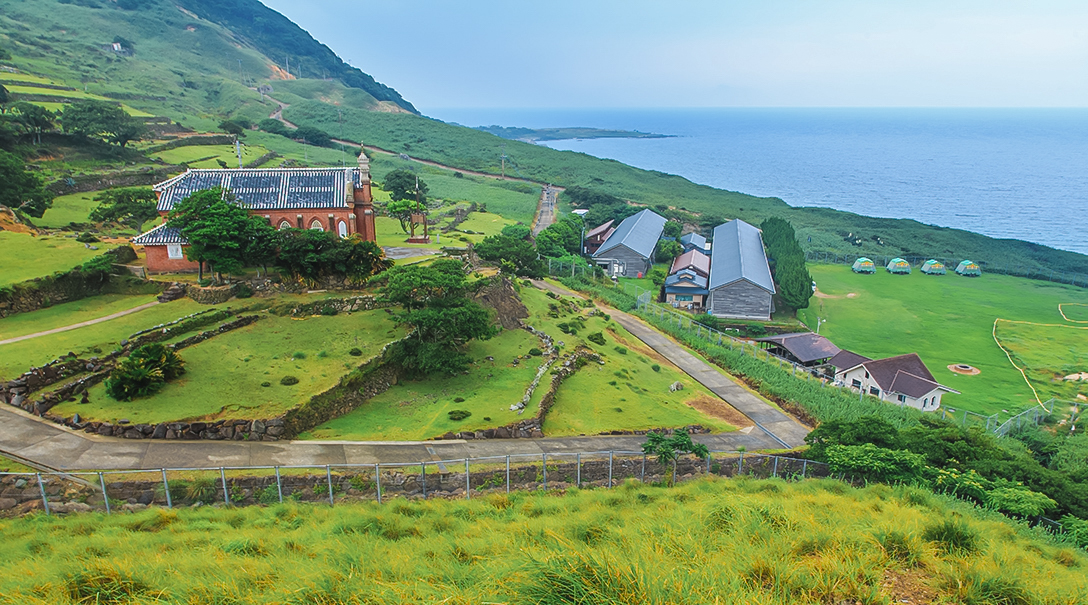World Cultural Heritage “Hidden Christian sites in the Nagasaki and Amakusa region”
Nagasaki and the Amakusa region of Kumamoto prefecture are located in the northwestern part of Kyushu. During the strict ban on Christianity in the Edo Period, Christians in this region who continued to practice their faith in hiding, developed a unique culture among themselves.
The “Hidden Christian sites in the Nagasaki and Amakusa region” is composed of 12 components that explain what caused Christians to go into hiding, how Hidden Christian traditions developed, how they maintained their faith, and finally the introduction of new aspects that led to the end of the Hidden Christians’ hiding.
In the “Kuroshima Settlement” we can see how Hidden Christians moved in order to reclaim land for farming, while maintaining their traditional faith in coexistence with the existing society and religion. Furthermore in the “remnants of the Nozaki Island Settlement” part of the heritage of Sasebo City, Ojika, we see how they settled and reclaimed land on the steep cliffs of an island sacred to Shinto, while maintaining their believes.
The Kuroshima Settlement

50 minutes by ferry from Sasebo City’s Ainoura Pier. Kuroshima Island, one of the Kujukushima islands was settled by many of the Hidden Christians escaping the severe repression and monitoring under the Shogunate’s ban on religion. While the history of the Hidden Christians contains many sad stories, the almost miraculous “Resurrection of the faith” on Kuroshima exists as a recorded historical fact, and to this day, the descendants of those believers continue to live in faith, protecting the nature and culture of the island.
Places to see on Kuroshima
Kuroshima Church

The construction of Kuroshima Church was started around the Bunka/ Bunsei period by Christians who moved there from Ikitsuki or Sotome. Kuroshima Church was built “As a symbol of Faith” by the people of Kuroshima, who had firmly held onto their believes even during the ban on Christianity. Kuroshima Church was designed and the construction of it was overseen by the French priest, Father Marmand, who with the donations of money and labor from the faithful, completed it in 1902 after two years of construction. Some of the 400,000 bricks used were made on Kuroshima, with the granite used for the foundation being quarried on Kuroshima as well. The brick building has high ceilings and a three tier construction, with even the smallest details such as the wood grain on the bundled supporting pillars and rib vaulted ceiling having being painted by hand. Being constructed in a very organized manner, it is said to have had a great influence on church construction after it.

Kuroshima Welcome House
This is the base for Kuroshima sightseeing located right by the harbor. It is also a reception office for various experience-based tours, and sells souvenirs and special products of the island. Please ask us for information about Kuroshima sightseeing.

Warabi Observatory
It is a observatory with a fine view where beautiful flowers bloom in each season. On sunny days, you can see Sakito-cho on the left and Kami-Goto islands on the right. You can also enjoy watching naval vessels or a huge luxury liner come and go on the sea.

Catholic cemetery
This cemetery was built around the same time as Kuroshima Church. It contains rows of granite headstones in the shape of a cross unique to Kuroshima, as well as older semi-cylindrical gravestones. Father Marmand also laid to rest here.

Café Misaki
Enjoy specially roasted Kuroshima blend coffee, prepared with Kuroshima’s natural mineral water. Food and sweets are also served, so please stop by at your convenience. Located next to the cafe is a spring imitating the miraculous Lourdes spring.
Phone: 0956-56-2310
Business hours 10:00~16:00 / Open year round

The cultural scenery of Kuroshima
During the Edo Period, Hidden Christians from various regions moved to Kuroshima in order to flee persecution. In the Warabe settlement, a form of land use typical to Kuroshima remains in the position of the Ocean – Hedge – House – Field, this particularly evident in the large number of houses with banyan tree hedges planted on the southern side in order to block the southern winds and strong western sun of summer.

Island food
A delicious meal consisting of freshly caught fish, island vegetables and Kuroshima Tofu. You can enjoy this meal at inn and ryokan (hotels) on the island. (reservations required)
Building repair and preservation work.
Starting in February 2019, Kuroshima Church will be undergoing preservation and repair work. As a result, in order to maintain safety, access to the site will be limited and the building will only be able to be viewed from on observation platform located outside. We apologize for the inconvenience and thank you for your understanding and cooperation.
※ Kuroshima Church will be open for regular viewing until preservation repair work starts. During the construction work, an observation platform will be installed and special public viewings are scheduled to be held.
〇 For enquiries regarding the observation platform or special public viewings.
Sasebo City Board of Education, Cultural Property Section TEL:0956-25-9634、Weekdays 8:30~17:15〈Saturday・Sunday・Holidays〉
〇 Construction period 2019, Feb. 4(Sun)~2021, Mar. (Scheduled) ※The construction period may be extended depending on the progress of the construction.
Access information
[Sasebo Station]ーBus 40 min. →[Ainoura Sanbashi (pier)]ーFerryー50 min.→[Kuroshima]
●Access from Sasebo Station to Ainoura Sanbashi
【Bus】 About 40 min.
【Matsuura Railway】 About 30 min. MR time schedule
【Taxi】 About 22 min.
Access from Ainoura Sanbashi (pier) to Kuroshima
【Ferry】 Ferry Kuroshima (Departing from Ainoura Port)
About 50 min. (3 ships per day)
Please contact us in advance when you visit Kuroshima Catholic Church.
The "Remnants of the Nozaki Island Settlement" pertains to the remnants of the settlement of the Hidden Christians who moved to this area sacred to Shinto in the 19th century, to continue their believes. While at its peak, about 650 people lived there, as depopulation continued in 1966 and 1971 two Christian settlements disappeared.
Remnants of the Nokubi Island settlement

Three hours by ferry from Sasebo city. Ojika is located to the north of the Goto Islands, and with a population of about 2500 people, the island retains a nostalgic Japanese appearance and was voted “most beautiful village in Japan”. Nozaki Island is located 2 kilometers east of Ojika Island.
The “Remnants of the Nozaki Island Settlement” pertains to the remnants of the settlement of the Hidden Christians who moved to this area sacred to Shinto in the 19th century, to continue their believes. While at its peak, about 650 people lived there, as depopulation continued in 1966 and 1971 two Christian settlements disappeared.
Places to see on Nozaki Island
The former Nokubi Church

On the island of Nozaki-jima, which was within the territory of the Hirado domein, there used to be two Christian villages, Nokubi and Funamori, where Christians were persecuted for making their faiths public. Nevertheless, they established churches in Funamori(1881) and in Nokubi(1882). Then they got united, worked hard cutting down on their living expences to build the current church in 1908. However, the residents left the island in 1971, and the church was abandoned. Now, the island is almost uninhabited, left with ruins of shrines and residences. In addition, more than four hundred wild Japanese deer inhabit the entire island, and you can observe in their natural environmant.
【A note to church visitors】
A prior notice is required when you visit the former Nokubi Church regardless of whether coming as individuals or in groups. Please contact: 0959-56-2646 at Ojika Island Tourism Association (9:00 a.m. – 6:00 p.m.)

The Nokubi Coast
With a length of about 300 meters, this white sand beach and the cobalt blue sea will make you want to cheer for its beauty. Located near the middle on the east side of Nozaki Island, it is also the perfect spot to watch the sun rise on a sunny day.

Okinokoujima Shrine
This shrine is said to have been built in the first year of Keiun (the year 704, Asuka Period), in such a manner that it faces the Chinokoujima Shrine across the bay on Ojika Island. The Okinokoujima Shrine is located directly beneath a huge standing stone know as "Oeishi" which can be found in a clearing after walking up a long mountain path.

Oeishi
A huge stone located on the far side of the Okinokoujima Shrine has been called "Oeishi" since ancient times. Standing 24 meters tall, and spanning 12 meters across both its pillars, with a table like stone on top, measuring five meters by three meters, it is very large.

Japanese deer (Cervus nippon)
Over 400 wild Japanese deer can be seen in their natural state across all regions of the island.
Nozaki Island Guided Tour
It is a short trek guided tour of history and nature in Ojika. You will see rare scenery such as former Nozaki settlement, the reddish land where wild deer flock to, and the white sand beach overlooked from the hill. We will also guide you to Former Nokubi Church. Now, nobody lives here except the manager of Nozakijima Natural Science Village (lodging facility). You can enjoy the nostalgic feel of this almost uninhabited island.









